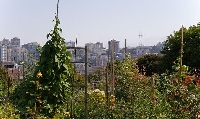What is a community garden
By Catalogs Editorial Staff

Exploring what a community garden is can create neighborhood bonds and goodwill
Vacant lots, unused swaths of land, and abandoned properties do not have to end up as an overrun collection of junk and weeds. Although sights like this are not uncommon, they do not have to be the norm. These parcels of land can have purpose and be productive. The land can make others productive, too, and can instill in them a sense of pride and self-sufficiency … the land can be transformed into a community garden.
Growing a Community
A community garden is land, whether publically or privately held, that has been designated for use for growing plants, whether for decoration, artistic expression, or production of food. The gardens may be tended by a few active members, or by many. Some community gardens issue its members ?plots? or ?allotments? consisting of a designated area of land within the garden for that specific member to tend. The size of the plot is dependent on the size of the garden, and American plot size tends to be smaller than European allotments.
Other community gardens forgo allotments and simply allow members to work collectively and to share the benefits of what is grown. In this case, it is up to each individual ?communal? garden to decide on how to allocate work and to distribute the harvest.
~
Who Can Participate?
Community gardens are not ?ninja gardening;? the members do not simply plant gardens where ever they wish. The gardens have a membership structure. Some gardens are considered ?top down? or ?grassroots? and other gardens have a democratic structure, and still others have appointed officials who handle the day to day management of the garden. In many cases, the member gardeners are expected to pay annual dues in order to defray the costs associated with the garden?s upkeep, recruiting new members, and fund raising.
Where Do These Gardens Grow?
The land for the community gardens can be held publicly or privately. In some cases, the land is donated, or use of the land is authorized by the owner for a specific time period in order to make better use of underutilized property. Some gardens are a result of an urban clean-up effort or revitalization project.
Communities interested in starting their own garden can get additional information from the American Community Gardening Association, where you can also locate existing community gardens. Let?s Move offers extensive information on how to get started, including check lists, and information from Master Gardeners. The USDA?s People?s Garden initiative provides an informative blog, a list of registered community gardens, information on getting schools involved in community gardening, as well as information on obtaining grants to help fund your community garden.
You Reap What You Sow
Some gardens are grown for beautification or revitalization of an area, and for the development of ?green space? in an urban environment. Other gardens grow only plants which can be consumed? vegetables, fruits and herbaceous plants.
The activity involved in tending the garden, the nutritious food harvested from it, and the social interaction with others in the community can provide many benefits for those involved. In addition, some community gardens choose to donate a portion of their harvest to local food banks or charities in order to share the benefits with others. According to the USDA, as of December 2012, community gardens donated 3.1 Million pounds of produce!
Community gardens are enjoying a huge resurgence in popularity and, considering the benefits of the gardens (both to those who tend the garden and those fortunate enough to share in its harvest), with any luck perhaps more of the derelict and weed-infested lots, piled high with debris, will soon be replaced with lush vegetation and industrious workers tending to their harvest.
Resources:
USDA: People?s Garden
Popular Savings Offers











